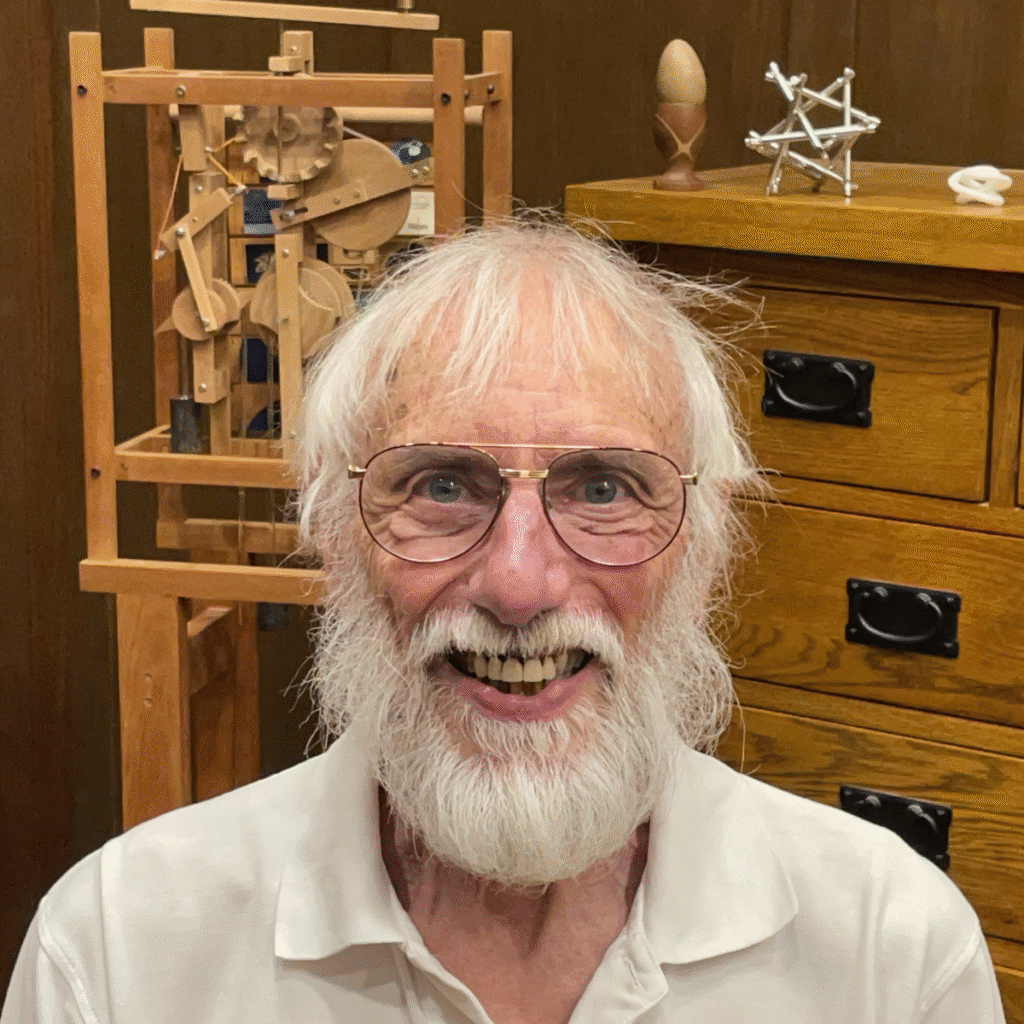
Member Profile: Geoff Wyvill
1. What do you do, and how long have you been doing it?
I enjoy the title of Professor Emeritus at The University of Otago in New Zealand and I am a director of Animation Research Limited, a company that grew from a business I started in 1989.
I am a problem solver, in some sense a ‘jack of all trades’. For most of my professional career, I have been what Americans call a ‘professor,’ although I did not receive that title until 2001. I have specialised in computer programming, particularly in graphics.
As for how long: I repaired my first clock at the age of nine, so I could claim 71 years of problem solving and amateur engineering.
Now I am officially retired, I’m doing more art and music. Most recently, I exhibited an installation, based on a Medieval clock design. Some of the mechanism is in the background of my profile picture.
2. What was your first job?
Lab technician for The British Rubber Producers Research Association in Welwyn Garden City. This was a vacation job while I was still at school.
My first professional job was “Technologist (Physicist)” at British Petroleum’s Sunbury Research Station. There, I studied the properties of lubricating oils and designed instruments for this work. It was there I wrote my first computer program in 1967. It calculated the capacitance between a sphere and a plane conductor. I needed this result for my work and my pure math failed me.
3. Where did you complete your formal education?
University of Bradford, Yorkshire, England.
4. How did you first get involved with ACM SIGGRAPH?
I first attended a SIGGRAPH conference in 1985. I was enjoying sabbatical leave in Canada. Before that, traveling to the US was too expensive and too disruptive for my young family.
I was asked to contribute a course on implicit surfaces at SIGGRAPH ’90 in Dallas. Following that I attended the SIGGRAPH conference regularly for the next 20 years.
5. What is your favorite memory of a SIGGRAPH conference?
In 1990, I was at the book launch of Prusinkiewicz & Lindenmayer: The Fractal Beauty of Plants when Jack Bresenham walked in. I introduced myself and told him I had wanted to meet him for years. He replied that he had wanted to meet me for years. I had no idea that anyone ‘that famous’ would have even heard of me. It was a wonderful introduction to the generous camaraderie of the SIGGRAPH Pioneers and SIGGRAPH in general..
6. Describe a project that you would like to share with the ACM SIGGRAPH community.
In 2001, Bob Parslow and I presented a SIGGRAPH course entitled “Seeing in 3D”. We sought to demonstrate that most people, including many engineers and designers, could not see, in their imagination, what even simple shapes like cubes looked like from a different angle. We demonstrated that it is a useful skill and one that can be learned.
We started to write a book on this topic but never. finished. Bob died in 2023 aged 97 leaving me as the only one likely to complete the work. I would like to finish the book and publish it free on-line. I’m also working on the idea of creating it as a web application that anyone can use to train themselves.
7. If you could have dinner with one living or non-living person, who would it be and why?
Not sure about dinner with a spirit from the grave, but I would love to. have one more conversation with Joseph Weizenbaum. His ideas on AI and the moral responsibility of the scientist are more important now, than ever.
8. What is something most people don’t know about you?
I am an amateur musician. Over the years I have played piano, violin, viola, viola da gamba, recorders of all sizes, Spanish guitar and cornet. I also have a small collection of unusual instruments such as the Taiwanese ocarina. I have performed in four different amateur orchestras, various chamber ensembles, a recorder consort and a wind band. I played in my own string quartet for about sixteen years.
With advancing arthritis, I no longer have the dexterity for violin and viola but I am learning bassoon.
9. From which single individual have you learned the most in your life? What did they teach you?
My father; he was an organic chemist but earlier in his life he had studied classics and philosophy with a view to going into law. He had a deep and wide knowledge of.science, politics, history and archaeology. He learned Russian because so much in his field was published in that language. Later, he taught Russian and published a text entitled Russian for Chemists. He made sure that I understood what was required of a good scientist and encouraged me to question everything and to check, where possible, original source material. I remember, particularly, when I was struggling to understand the theory of relativity, he directed me to Einstein’s own book “The Theory of Relativity”. It was much easier to read than any of the numerous ‘simplified’ explanations published at the time.
10. Is there someone in particular who has influenced your decision to work with ACM SIGGRAPH?
I have received enormous support and encouragement over the years from many of the better known stars of SIGGRAPH. To single out one, would not be fair.
11. What can you point to in your career as your proudest moment?
In 1989 Bob Parslow and I started an informal activity at The University of Otago that we called “The Advanced Programming Workshop.” Its purpose was to train a team to enter the ACM Scholastic Programming Contest, now known as the International Collegiate Programming Contest.
Our 1989 team came 10th. and our 1990 team won. It was the first non-US team to do so.